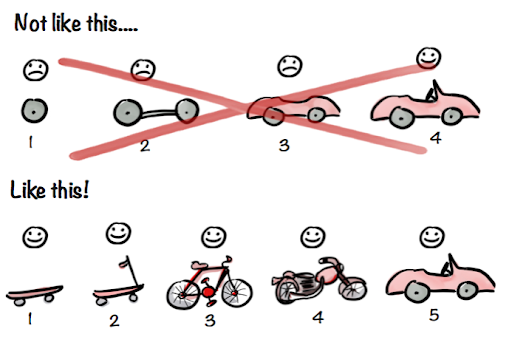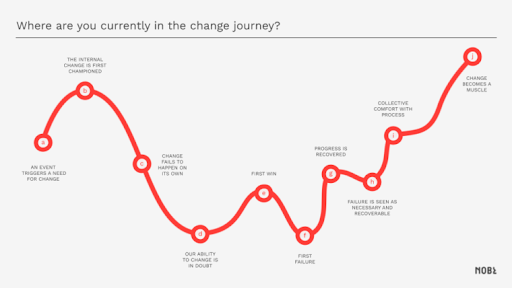When we begin a coaching conversation with a leader trying to change their company culture, we often evoke the image of crossing a turbulent river to illustrate their upcoming journey as we ask, “What’s to be found or gained by reaching the other side? What can you leave behind now to ease the burden of the crossing? Whose help might you need? And ultimately, who do you want to be when you emerge on the other side of this journey?”
It’s a bit hokey, sure, but it always elicits a meaty conversation about growth and transformation. At NOBL, all of our clients are grappling with who they must become: some are reacting to dramatic changes to their industry, while others are wisely using the moment to accelerate change to keep ahead of the market.

NOBL has helped world-famous organizations change collective behavior and business outcomes. Reach out to see how we might be able to help your organization.
No matter what the cause, executives at these organizations are asking themselves deep questions not only about their products and operating models, but of their company culture: Can you change organizational culture in the first place? How must we show up together to bring about sustained transformation? What must change about what we value from one another? What do we want to retain from this era of new tools and new ways of working?
A watershed moment for organizational culture
When we founded NOBL in 2014, company culture was still largely considered “soft and fuzzy,” a thing for only HR professionals to focus on, and something that management felt could be changed with pithy slogans and ping-pong tables. Today, an organization’s culture is increasingly seen as essential to fulfilling the business model itself. Ways of working, behaviors, and norms are talked about in boardrooms, changes are spearheaded by CEOs, and project budgets increasingly recognize the complexity of the task. Organizations are far better educated and sober about the river crossing to come. Below, you’ll find some of the most important lessons we’ve learned partnering with world-renowned companies going through organizational culture change.
Ensure the management team has a shared understanding of “culture”
Because “culture” is complex, leaders can talk endlessly about the issue without ever knowing if they are aligned with their peers. You don’t need a perfect definition, just one that articulates the possible playing field for change.
We define culture as an emergent property of interpersonal interaction, mediated by the organization’s environment, purpose, strategies, structures, and systems. Breaking this down, that means:
- Culture is an emergent property: Culture is like the weather in that it’s an always-changing product of many interacting systems and actors. It’s organic; it emerges. But, unlike the weather (yet), they can also be formed intentionally. People can and should be thoughtful, purposeful, and responsible around the behaviors, values, attitudes, beliefs, and assumptions they share. This means employees can be empowered to design the desired culture, but they have to view culture holistically.
- Of interpersonal interaction: Culture is foremost produced by how the members of your team interact with one another. Of course, how they interact is influenced by everything from societal norms to corporate policies and values (implicit or explicit).
- Mediated by the organization’s environment, purpose, strategies, structures, and systems. Organizations have four domains that you can impact:
- Purpose: what draws folks to your organization
- Strategies: what trade-offs they make in decision making
- Structures: how they are organized into teams
- Systems: the internal norms, processes, communications practices, and tools they use to get their work done

Again, your leadership team doesn’t have to adopt this exact definition. But if one person thinks of “happy hours” while another thinks of “performance reviews,” when you discuss company culture, you’ll struggle to make any meaningful cultural change.
Align your strategy with how you work
How an organization works should be aligned with its market and strategy, not the latest business book or Harvard Business Review case study. We like to think of this as culture/market fit.
To that end, we need a model and process for aiming for exactly what we want and need. We use The Competing Values Framework and have found it quite useful in helping leaders articulate the kind of organizational culture they aim to foster.

Moreover, we believe it helps identify the fundamental connection between market strategies and organizational culture; there’s a reason why the leaders in most markets have a unique (for their market) and focused organizational culture. Don’t just pick words or directions from a hat, focus on what your market and customers need.
Educate yourself on the emotional aspects of cultural change
Many times, leaders barge into a situation with wonderful new ideas of how great a culture change will be, only to find that people are more concerned about small losses. Why can’t people just be rational and adopt the new way we’re proposing that’s so obviously superior to the old way? We’ve found there are two main obstacles leaders must overcome.
First, they must establish greater psychological safety—that is, individuals must feel that it’s safe to take risks in front of others. An employee can share a new idea (“let’s change how we run meetings”) or bad news (“we didn’t hit our numbers”) without fear of judgment or reprisal. If teams sense it’s unsafe to try new things, no culture change is possible.
Second, they must help team members cope with loss. Even the best changes can still trigger loss-avoidance behaviors. The goal of understanding loss is to keep change resistance low throughout the culture change; ensuring greater speed of adoption.
Focus on behaviors, not attitudes
When it comes to changing organizational culture, people like to think it’s as easy as the ABCs: if you could get people to adjust their attitude, that will influence their behavior, resulting in culture change. But the funny thing about humans is that sometimes, it’s just the reverse—your behavior actually impacts how you feel about things.
In other words, don’t worry so much about attitudes—you don’t necessarily need everyone to be “rah-rah” about doing things differently. Start by making real changes to behavior and let attitudes come around. Before sharing what changes you want to see, make sure the behaviors you’re asking for are applicable, simple, advantageous, testable, and observable. If any of these factors is missing, you risk a higher rate of rejection.
You should also evaluate different motivations and incentives. If people don’t get onboard with your proposals right away, don’t assume it’s out of spite or laziness. They may have perfectly valid objections, or their incentive structure may not align with what you’re asking for.
Whatever you do, avoid launching a change communications effort too early, as they often over promise or try to cheerlead, which can lead to increased skepticism or cynicism.
Build a coalition for change
We’d all like to think that our attempts to improve the organization’s culture will be enthusiastically welcomed and embraced by our teams. In reality, though, when launching any new cultural initiatives, you’ll encounter a variety of reactions, from enthusiasm and hope to skepticism and even sabotage.
Your first goal is to identify co-pilots: these are the folks who will go to the mat for you and help you shape your change. Not only that, they have the skills to guide others through culture change.
Next, look for champions. They’re inspired by the possibilities of change. In fact, they may already have tons of suggestions for what and how things need to change, even if they don’t necessarily have the skills to deliver it (yet). They’re also crucial sources of influence who help rally the troops.
Most of the organization, though, will consist of skeptics or fence-sitters, waiting for proof that change is happening before they commit. As tempting as it may be to write them off, remember that every employee is likely to believe that their way of dealing with change is the only smart, tactical way. And in fact, most are responding sensibly to some aspect of the organizational environment in the messy process of change. Instead of trying to show them why they are wrong, focus on making changes visible. If circumstances change, minds will change, too.
Approach new behaviors through a “minimum viable product” lens
Especially in large organizations, any major culture change will require extensive time and resources to implement—which you may not have in the face of a rapidly evolving market. Instead, we recommend applying small, quick fixes to learn and improve as you go.

Spotify refers to this method as “starting with a skateboard”—the idea being that a skateboard and a Cadillac will both get you from Point A to B, but one will be a lot easier to build if you’re starting from scratch. Look for ways to test a small change in a low-risk environment: what is the fastest, cheapest way you could find out if it’s the right move? That’s your first skateboard.
Then, take your skateboard for a test ride and collect data. You’re not looking for “success” or “failure”—instead, the results will validate or invalidate your assumptions. In fact, invalidating an assumption can end up being far more useful, as it will prevent you from wasting time and money on ideas that are dead-ends. As you continue testing and iterating, you’ll not only develop the solution best suited to your organization, you’ll also teach your team valuable skills for learning and adapting.

In our Organizational Changemaking model, we explicitly call out organizational culture as a domain of change that should be approached through an agile process of testing and learning.
We recommend drafting your mid-level management to identify and own this process, as they already play a vital role in turning executive directions into measurable actions. To even make time for change, you may need to help these managers find work they can stop or processes they can simplify.
Codify and reward new behaviors
Organizational muscle memory, risk avoidance, and even change fatigue can derail your early momentum. The moment to champion change is as soon as you have actual proof of success: when folks who have produced observable changes that you can highlight and reward in full view of their peers. These co-pilots and champions should also be called on to train their peers in the organization on new ways of working.
You should also begin codifying their new behaviors as standard operating procedures; which should include new process documents, as well as being distilled into a “culture contract” that can be used to hold the organization accountable for sustaining its new culture(s).
Accept that change is a journey
When we first start changing organizational culture, the promise of a better future is invigorating. It’s easy enough to imagine a clear directives that allow teams to effectively prioritize projects; a company culture that allows for clearly defined roles and a spirit of collaboration; a workplace where flexible hours and remote policies are the norm.
But then you start implementing changes, and reality sets in. The daily demands of your business prevent you from focusing on necessary, but not “urgent,” changes. You encounter resistance from team members who disagree with your approach, or even have a vested interest in the status quo. At your lowest point, you may even doubt that changing company culture is possible, and consider abandoning the project.

A change journey diagram provides perspective. How you feel today is just that—a reflection of today, not necessarily of the whole process. If you’re feeling frustrated by the lack of change, you may be just a short period away from your first big win. And if you’re feeling like everything’s running smoothly? Well, watch out for a bump in the road!
By sharing this diagram at the beginning of your change initiative and referring to it throughout the process, you can also conduct pre-mortems and anticipate (and counteract) resistance to change. As a result, the lows are mitigated, and you can brainstorm ways to get back on track.
Together, change is possible
Changing organizational culture is a monumental task, but it’s always possible. We’ve seen firsthand what happens when employees are allowed to experiment with new ways of working; when leadership not only develops a vision for change but is prepared to guide employees through the inevitable challenge and loss that accompanies change; and the excitement when teams realize they’ve truly achieved culture change. Want to learn more? Sign up for our weekly newsletter to receive practical tips and insights into how to lead your organization through a successful transformation.








The Evolutionary Edge
Every Link Ever from Our Newsletter
Why Self-Organizing is So Hard
Welcome to the Era of the Empowered Employee
The Power of “What If?” and “Why Not?”
An Adaptive Approach to the Strategic Planning Process
Why Culture/Market Fit Is More Important than Product/Market Fit
Group Decision Making Model: How to Make Better Decisions as a Team